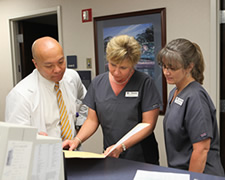Treatments

Cataract Surgery
Thomasville Eye Center is now using the Catalys Precision Laser System to perform many key steps of the procedure that are traditionally performed using handheld instruments. This laser precision enables our surgeons to provide patients a comfortable, gentle and highly customized cataract treatment.
A cataract is any clouding of the normally clear lens of the eye. A natural part of aging is a gradual clouding of this lens. Diabetes, medications, injuries and other factors can hasten the clouding of your natural lens. We refer to this clouding of the lens as cataract development.
Blurred vision or glare causing difficulty with everyday tasks, such as driving, watching TV, or reading can be caused by cataracts. Your optometrist or ophthalmologist can determine if cataracts are affecting your vision during an eye examination. Many people with cataracts may experience symptoms such as:
- Cloudy, fuzzy, foggy vision
- Difficulty in seeing to drive, especially at night
- Trouble seeing to do close work
- Problems watching television
- Colors that seem dull, faded, not as bright
- Frequent changes and a stronger glasses prescription
- Halos around lights
- Bothersome glare
Cataract surgery is recommended when your vision is no longer adequate to comfortably perform your everyday activities.
Hold your smartphone over QR code so that it’s clearly visible within your smartphone screen for more information.

Cataracts can only be corrected with surgery. Recent advances in cataract surgery have improved its safety and effectiveness. Studies have shown that most patients notice a significant lifestyle improvement following cataract surgery due to better vision.
The surgery takes less than ten minutes and is painless. You are usually in and out of our facility in less than 90 minutes. We have an anesthetist present to assist patients with sedation so that patients are not anxious before or during the procedure.
Our Surgery Center which is part of our office in Thomasville is accredited by the Joint Commission on Accreditation of Healthcare Organizations.
During cataract surgery, your ophthalmologist removes the cloudy natural lens and replaces it with an intraocular lens (IOL) in order to restore your vision. This is a small artificial lens, usually made of silicone or acrylic material, surgically and permanently placed inside the eye.
Premium IOLs
Introduction
Medicare has recently changed policy allowing you to have a refractive surgery option with a presbyopia correcting IOL (intraocular lens) if you are willing to pay some additional out of pocket cost. This refractive surgery option might allow you to go without glasses for both distance and reading. Some choices can even give you computer vision without glasses.
What is presbyopia?
As we age, most patients need reading glasses or bifocals. This condition is called presbyopia. New implants called presbyopia correcting IOLs (Restor® ,Tecnis® Multifocal, and Symfony®)have been developed to compensate for both distance and near vision. These are not appropriate for all patients. The various choices of IOLs are described below.
Premium IOLs (Panoptix, Vivity)
Multifocal IOLs are somewhat like trifocals in that they have different rings of focus built into the IOL. They offer reduced dependence on glasses following cataract surgery by providing simultaneous near and distance vision in each eye. One downside to these lenses is they can cause glare and halos at night which can be enough to interfere with nighttime driving.
- Visit the Panoptix Website for more information.
- Visit the Vivity Website for more information.
Although multifocals may represent one of your best options for reducing your dependence on glasses, it is not possible to guarantee that you will be able to throw away your glasses. Multifocal lenses work best when placed in both eyes so that both eyes can work together.
Single Focus IOLs
This choice is made for most patients. It uses tried and true technology to correct vision to a single fixed focus, usually distance. Patients with single focus implants usually have good distance vision, but may need glasses for reading. Medicare and insurance will cover the cost of these IOLs.
Patient Frequently Asked Questions
Patients can resume normal activities the day after surgery. There are no physical restrictions. Bending and lifting are not a problem. You can wash your hair the day after surgery. We do request that you not rub your eye for several months.
No. Once cataracts are removed, they cannot come back. In about 30% of patients, the lens capsule that supports the intraocular lens will become cloudy over time. This usually happens one to two years following surgery. We then do a YAG laser to open the capsule, and this restores good vision.
Probably. One of our goals with modern-day cataract surgery is to reduce patients’ dependence on glasses. We frequently have patients able to drive without glasses following surgery. Many patients still need glasses for reading. We will take measurements and change glasses approximately four weeks after surgery.
No. Your eye will be thoroughly anesthetized with either drops or a local anesthetic. We will also give you some intravenous sedation to take care of any anxiety.
No. We gently prop your lids open with a speculum during surgery and your eye stays right where it belongs. The topical anesthetic makes this quite comfortable, and there should be no pain involved.


